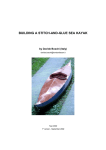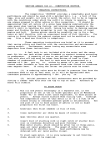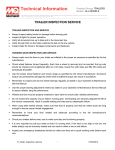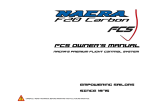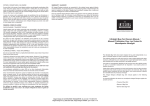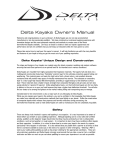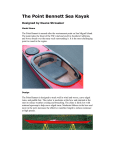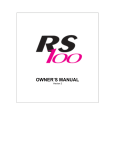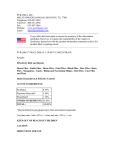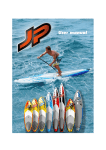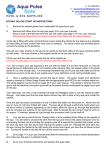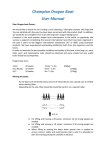Download OWNERS MANUAL - P&H Sea Kayaks
Transcript
OWNERS MANUAL 91 CONTENTS Page 4 INTRODUCTION Page 7 CARE & MAINTENANCE Page 11 WARRANTY INFORMATION Page 12 CONTACT INFORMATION 2 3 INTRODUCTION Congratulations on your purchase and welcome to one of the finest lines of British designed and manufactured sea kayaks on the planet. ABOUT P&H CUSTOM SEA KAYAKS As our tag line "The British specialists in sea kayak design" suggests we have a long pedigree for fine designs and outstanding craftsmanship. Being out on the water is in our blood and we pride ourselves on delivering the choice, quality and innovation you would expect from people who not only design and build kayaks but who actually use them too. Our experience is what has kept us at the very forefront of the industry since we started designing and manufacturing sea kayaks here in the UK over 30 years ago. Our factory is still on the same site in Derby in fact. The skill, dedication and passion of all our staff is what takes the company forward and importantly maintains these high standards and we hope reassures you that owning a P&H kayak is the right choice. We have built this kayak just for you and we hope you enjoy paddling it for many years to come. ABOUT THE USERS MANUAL We’re sure that you know that sea kayaking is a fun, enjoyable and very safe sport, however we want to make you fully aware of all the possible safety information you may need so this manual does contain a lot of “Warnings” and “Cautions” concerning the consequences of failure to maintain or inspect your kayak or the failure to follow safe paddling practices. Most of the information is logical and should make sense to you but its important that we point it all out in any case as you forget something or perhaps just did not realise how important it is. Please do not be alarmed by this intense warnings and cautions information within this manual, it condenses over 30 years of experience we have in manufacturing sea kayaks in to just a few pages! However this information is important and you should read it fully. We hope that you have many years of enjoyment, adventures and safe paddling ahead of you with your new P&H sea kayak! The combination of the safety alert symbol and the word ‘Warning’ indicates a potentially hazardous situation which, if not avoided, could result in serious injury or death. The combination of the safety alert symbol and the word ‘Caution’ indicates a potentially hazardous situation which, if not avoided, may result in minor or moderate injury, or damage to your kayak or a component. Because the consequences of not following a Warning usually include “you may lose control” which could result in serious personal injury or death, we may not repeat this in conjunction with each Warning. Because it is impossible to anticipate every situation or condition which may occur, a practice or situation may be unsafe but not anticipated by this manual. So, don’t forget to use your common sense. WARNING: MAKE SURE YOU HAVE, REVIEWED, AND UNDERSTOOD THE WARNINGS, INSTRUCTIONS, AND CONTENT OF THE MANUAL FOR YOUR KAYAK. ALSO READ THE SAFETY INSTRUCTIONS LOCATED INSIDE YOUR KAYAK. 4 The following warnings and advice are aimed as a guide and cannot, by the nature of the sport, be fully comprehensive. They are intended to help you make a more informed decision as to whether you should participate. If you are not willing to assume all risks to yourself or others and abide by a duty to care for other water users, you should not go kayaking. The user of any P&H Sea Kayak product is personally responsible for his/her own safety and assumes all risks and all responsibility for any injury or death, which might occur while using any product. All forms of sea kayaking can be dangerous and physically demanding in some situations. To enter exciting and challenging situations in relative safety, the paddler should have relevant knowledge, skill, training and build experience in controlled situations. Consult your national sports governing body who should offer comprehensive training and advice on how, where and when to paddle. Kayaking contains inherent risks including, but not limited to, property damage, the risk of personal / catastrophic injury or death. All risks may be increased by variations in sea states and tides weather conditions, other persons or other causes. All paddlers must constantly exercise and review their own judgment for the safety of themselves or others. P&H sea kayaks recommend that at all times you wear appropriate safety equipment, such as an approved PFD [personal flotation device], approved helmet (if applicable) suitable clothing and spraycovers. Not every kayak is built for every activity. Check with your P&H dealer to make sure you have the right equipment. No kayak is indestructible. Rescues, rough or storm conditions, seal launches and beach landings all increase the wear and stress on every part of your kayak. Shells or parts under high stress may fail, causing you to lose control. Because of the risk involved, P&H Sea Kayak recommends that you conduct a thorough inspection before each paddle. If you hit an object, have to wet exit your kayak or drop kayak, inspect yourself for injury, then carefully inspect your kayak for damage. Here is what you should look for when you inspect your kayak for this type of accident: cracks, scratches, deformation, or discoloration in the shell seam or bulkheads. Gouged, bent or broken components, such as the seat, toggles or end grabs, safety points, thigh grips, footrests. Also check all deck lines and fittings for signs of damage. Because damage may be internal and hidden, if any signs are present, stop paddling until your kayak has been thoroughly inspected by your P&H dealer. WARNING: ALTHOUGH MANY CATALOGUES, ADVERTISEMENTS AND ARTICLES ABOUT KAYAKING DEPICT PADDLERS PADDLING IN ROUGH CONDITIONS, SURF AND TIDAL RACES / RAPIDS THESE ACTIVITIES ARE EXTREMELY DANGEROUS, INCREASING THE PADDLER’S RISK OF INJURY OR DEATH, AND POTENTIALLY INCREASES THE SEVERITY OF ANY INJURY. THE ACTION DEPICTED IS BEING PERFORMED BY EXPERTS WITH MANY YEARS OF TRAINING AND EXPERIENCE. EVEN WITH THAT TRAINING AND EXPERIENCE, PADDLERS WHO ENGAGE IN SUCH ACTIVITY MAY GET SERIOUSLY INJURED. IT IS ALSO FORESEEABLE THAT IN SOME ROUGH WATER OR WHITE WATER SITUATIONS, AND EVEN DURING SOME COMPETITION, THAT THE PADDLER WILL EXCEED THE DESIGN CAPACITY OF THE SHELL OR COMPONENTS, WHICH MAY RESULT IN SOMETHING ON THE KAYAK BENDING OR BREAKING. IF A SHELL OR COMPONENT BENDS OR BREAKS, SUCH MAY LEAD TO LOSS OF CONTROL, SERIOUS PERSONAL INJURY OR DEATH. 5 SERVICE AND MODIFICATIONS Technological advances have made kayaks more complex, and the pace of innovation is increasing. It is impossible for this manual to provide all of the information required to properly repair or maintain your kayak. In order to help minimize the risk of injury any work carried out on your kayak should be performed by a P&H Dealer. Your kayak has been engineered and tested with specific components and parts. Because of the great variety of these parts, it is impossible for P&H to check and approve all combination of parts. Modifying the shell or components may make the kayak unsafe. For example fitting a tow system could change the handling characteristics of the kayak and or add stress to the shell which have not been tested for. If you wish to add components, have this done by a P&H Dealer. For more information about caring for your purchase, please refer to the care and maintenance section in this user manual. WARNING: NEVER MODIFY YOUR KAYAK IN ANYWAY. DO NOT SAND, DRILL, FILL OR REMOVE PARTS. AN IMPROPERLY MODIFIED KAYAK COULD FAIL AND CAUSE YOU TO LOOSE CONTROL. CAUTION: ANY MODIFICATION TO YOUR KAYAK OR COMPONENTS MEANS THAT YOUR KAYAK NO LONGER MEETS OUR SPECIFICATIONS AND THEREFORE VOIDS YOUR WARRANTY. 6 CARE AND MAINTENANCE P&H SEA KAYAKS - CARING FOR YOUR SEA KAYAK In order to ensure your kayak stays in good condition please take a little time to read the following guidelines: GENERAL CARE OF YOUR KAYAK o INTERIOR - Following a period of use, it is always a good idea to inspect the front and rear compartments as well as the cockpit area for damp gear, food ect. that you forgot you put there! The kayak should never be stored for long periods with any water inside, empty the kayak and use a sponge to mop up the last bit of water. Rinsing the interior with fresh water every now and again is general good practice. Allow storage compartments to dry properly before replacing hatch covers. o EXTERIOR - Frequent washing with clean fresh water will prolong the life of your kayak. Refrain from leaving your kayak lying in the sun. All P&H kayaks are manufactured with strong ultra violet stabilizers but over a prolonged period of time exposure to the sun can fade the outer gelcoat colouring on composite kayaks and shorten the life of polyethylene kayaks. o STORAGE - Whatever length of time you intend to store your kayak you should store it with good support. This definitely means not leaving your kayak sitting for any period of time on a set of narrow bars or beams, as it may acquire a “dent”. If hanging your kayak then straps (at least 2” (50mm) wide) should be used. Hang the kayak in the straps at points about one third in from each end [DO NOT HANG THE KAYAK BY THE TOGGLES]. Kayaks can also be stored on their side, on a soft flat base, with the hull towards a wall. They can be stored outside and upside down but should never be allowed to lie in water for long periods. When stored outside they should be checked on a monthly basis to ensure they are not attracting mould or some fungi. Always ensure kayaks are stored with the inside dry. 2” [50mm] straps 1/3 distance from each end 7 TRANSPORT The most important thing to remember when transporting your kayak is to make certain that it is tied securely. WE STRONGLY RECOMMEND YOU NEVER CARRY A KAYAK WITH THE HULL FLAT ONTO A ROOF RACK BAR. We recommend that our kayaks are always carried in well-padded carriers or leaned, on their edge, against a roof rack upright. If using carriers these should ideally be a minimum of 3” (75mm) wide and designed for the suitable style of kayak. The more of the carrier touching the kayak the less likely it is that the kayak will be dented. Whichever method is used, any area touching the kayak should be well padded with firm foam. This also protects the kayak and stops it moving around whilst in transit. CAUTION: P&H MANUFACTURES BOATS FROM THE BEST MATERIALS AVAILABLE USING INDUSTRY LEADING QUALITY CONTROL PROCEDURES. CONTINUOUS TESTING AND MONITORING IS COMPLETED TO MAINTAIN THIS. P&H ALSO MAKE KAYAKS FOR PADDLING ON A BROAD RANGE OF WATERS. YOU WILL REDUCE THE LIFE OF YOUR BOAT BY REPEATED ABRASIONS AND IMPACTS, MATERIAL FATIGUE CAN ALSO BE CAUSED BY LEAVING IT IN THE SUN FOR LONG PERIODS. RESISTANCE TO IMPACTS MAY BE REDUCED IF USED IN VERY LOW TEMPERATURES. SEAL LAUNCHING OFF ROCKS OR BEACH LAUNCHING WILL ABRADE THE HULL, ULTIMATELY SHORTENING YOUR CRAFT’S LIFE. DRAGGING THE BOAT TO AND FROM THE WATER WILL ALSO HAVE THE SAME EFFECT. PLEASE REMEMBER THAT DAMAGE TO YOUR CRAFT THROUGH WEAR AND TEAR IS NOT COVERED UNDER WARRANTY. If you chose a lightweight construction it will require slightly more care when handling and paddling. o Try to avoid direct ‘hard’ impacts with objects which can dent and/or delaminate the lightweight constructions o Do not transport lightweight boats directly onto hard metal racks. Appropriately shaped padding or kayak carries should be used to eliminate stress concentrations when transporting these boats. 8 CARE OF SKEGS It is always a good idea to check the skeg housing for any little pebbles or other debris that might have lodged and ensure that the skeg is functioning properly before you start and at the end of your trip. o GENERAL CARE OF WIRE SKEGS - The retractable skeg should be removed and the wire lightly lubricated once a year (something else to add to your pre-season checklist). Insert the small Allen (hex) key provided into the skeg slider knob (a) and loosen the grub screw, which holds the wire. Unhook the skeg unit (b) and remove from the hull of the kayak, slowly pulling the skeg wire completely out. After a light lubrication (spray furniture polish is ideal as it is generally silicone based) the skeg wire and skeg can be reinstalled as above. When reinstalling move the skeg slider knob to the rear position and set the skeg in the furthest down position you want it then tighten up the grub screw in the slider. Check the operation of the skeg unit and that when raised the skeg is completely in its housing. NOTE: Do not use oil on the wire as it may attract dirt into the tubes and jam the cable. o GENERAL CARE OF DYNEEMA CORD SKEGS - Clean the skeg system with fresh unsalted water every couple of trips. Every few months inspect the skeg system for signs of general wear and tear. There is no need to remove the skeg system for this, a visual inspection of the shockcord located in the skeg housing (c) and Dyneema control line (d) will do adequately. In the field running repairs can be made with any thin cord (2mm) that will pass through the tubes. New skegs and spare parts are available from your local P&H dealer. a b - For wire skeg c d - For dyneema skeg a b d c 9 10 WARRANTY MANUFACTURERS WARRANTY (Limited one year) P&H make a warranty for one year from the date of retail purchase, that this product is free of defects in material and workmanship only. The warranty is not transferable, as warranty does not apply to second hand craft. The Warranty Registration Form must be completed and returned to make the warranty effective. P&H does not warrant that this Kayak is unbreakable. WHAT IS COVERED: Repair including labour or replacement, at P&H’s option, to all or any parts of the product, at P&H’s discretion. WHAT IS NOT COVERED: Transportation charges either way. Damages caused by abuse or failure to carry out normal maintenance. Alteration or repair by non-P&H approved personnel. Any rental kayaks. Any other expense. Consequential damages. Incidental damages including damage to property and personal injury. Wear and tear. HOW TO MAKE A WARRANTY CLAIM: Contact the dealer who sold the Kayak to you for advice and to see if they agree that you may have grounds for a claim. You will be required to provide the dealer with the following information: o Your name o Your address o Your telephone number o A description of the problem o A description of how it happened and any witnesses o Why do you feel that it is a warranty problem? o Boat serial number (normally on the stern or inside the cockpit of the kayak) o Where purchased o Date of purchase o Proof of purchase 11 UK and Worldwide: P&H Custom Sea Kayaks Marina Village Preston Brook Runcorn Cheshire WA7 3DW England North America: P&H Custom Sea Kayaks c/o Pyranha US, Inc. 2004-J Riverside Drive Asheville NC 28804 U.S.A MODEL SERIAL NUMBER WWW.PHSEAKAYAKS.COM 12

















